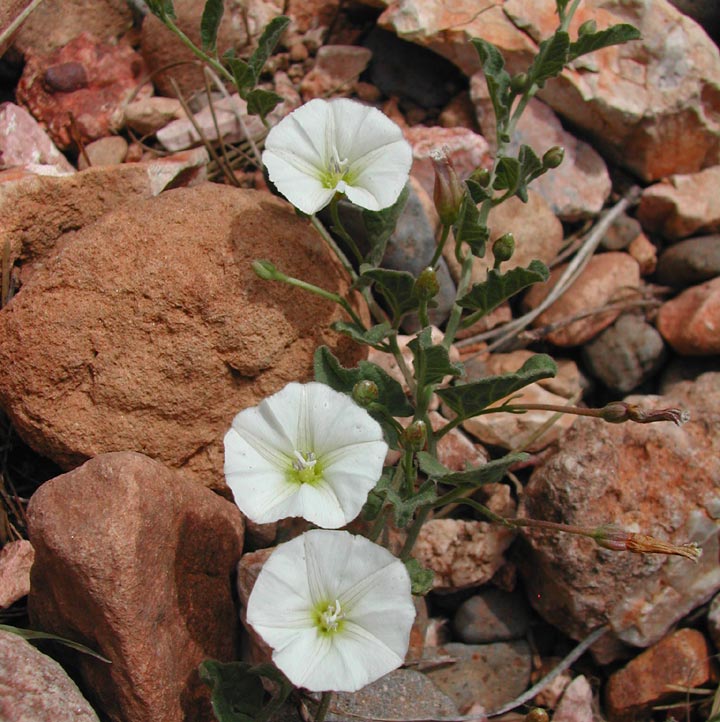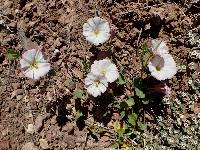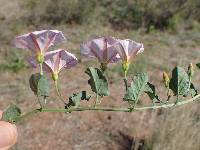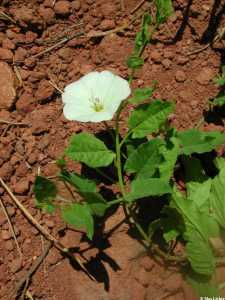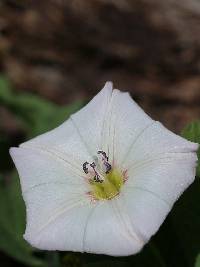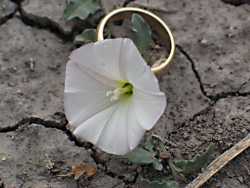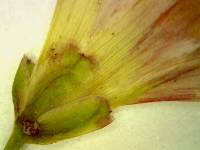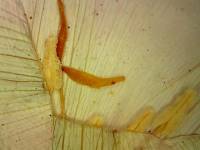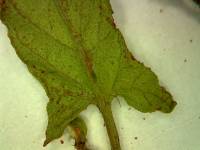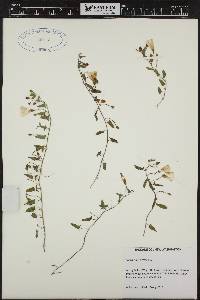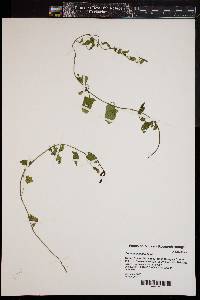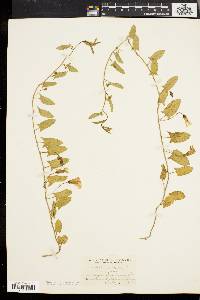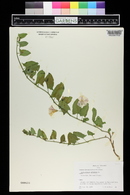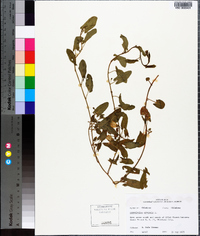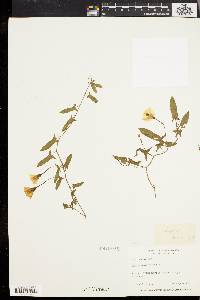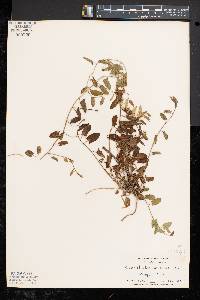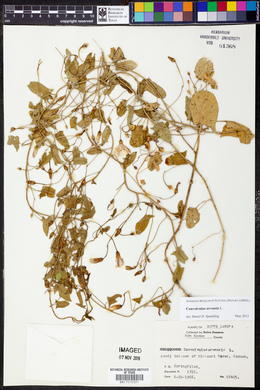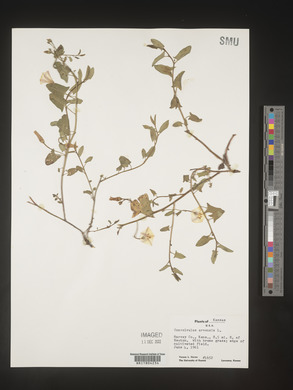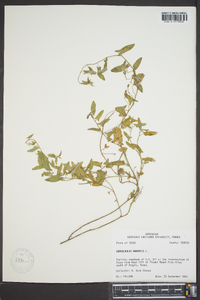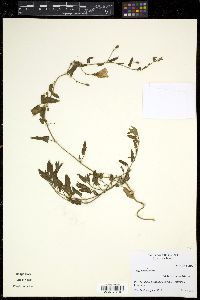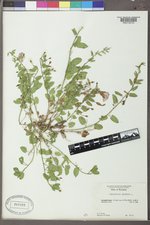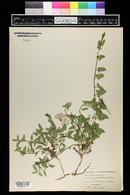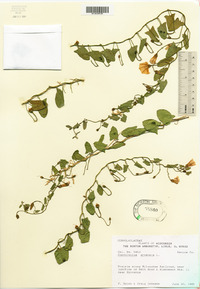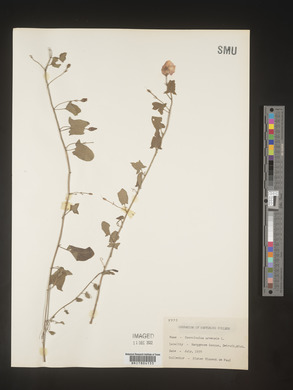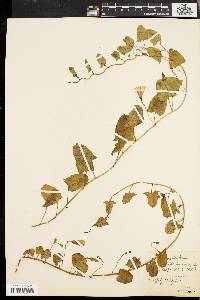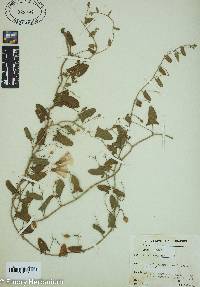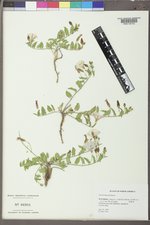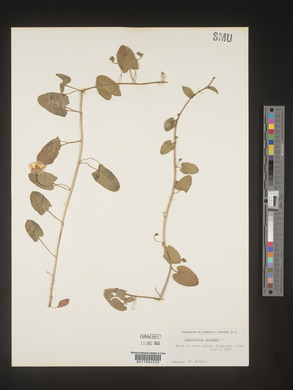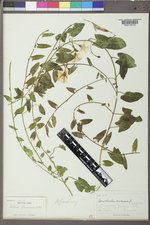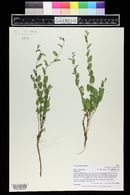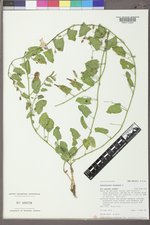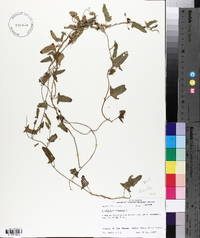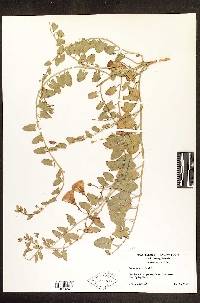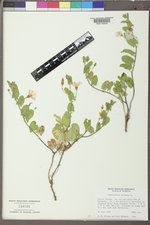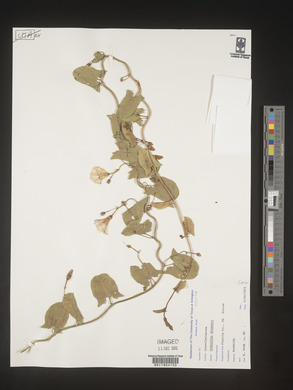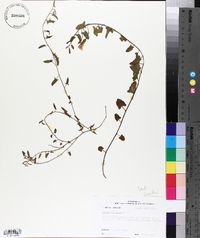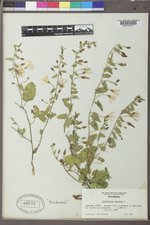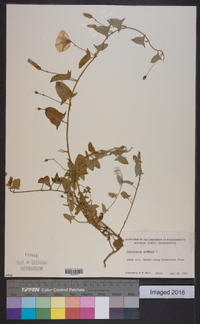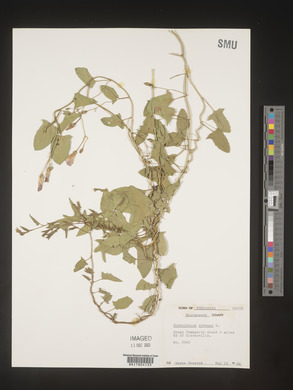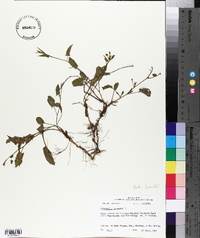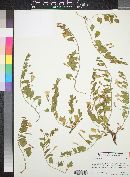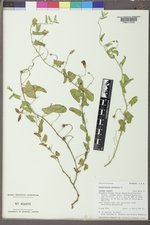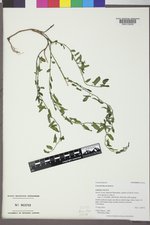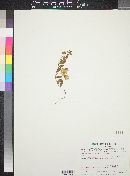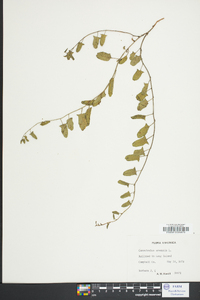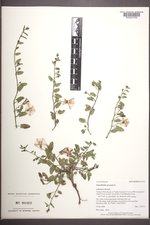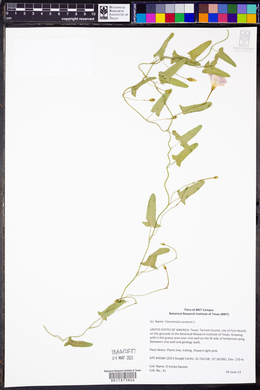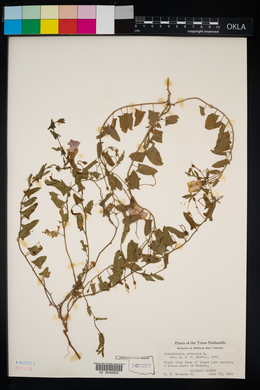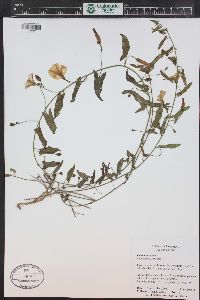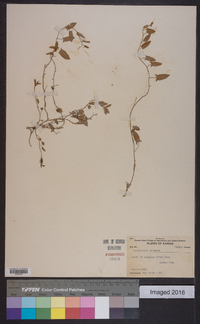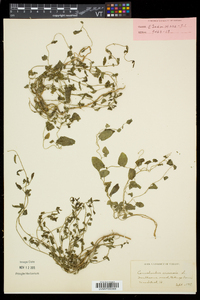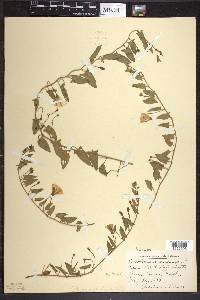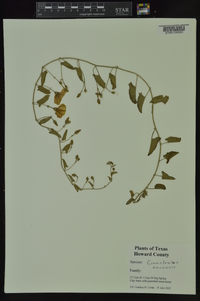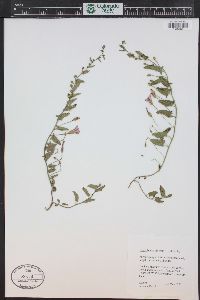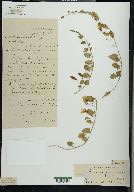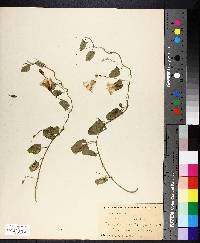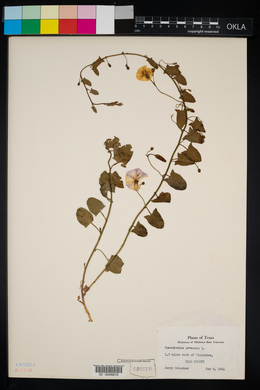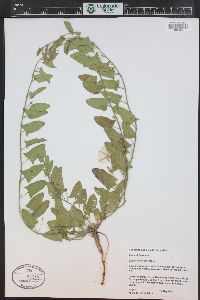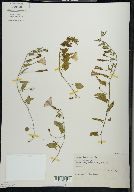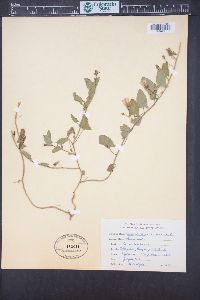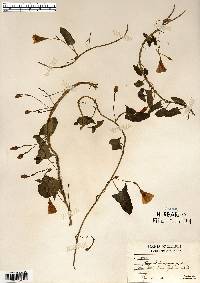
|
|
|
|
Family: Convolvulaceae
Field Bindweed, more...creeping jenny, European bindweed, morningglory, perennial morningglory, smallflowered morning glory (es: correhuela)
[Convolvulus ambigens House, moreConvolvulus arvensis var. linearifolius , Convolvulus arvensis var. obtusifolius Choisy, Convolvulus arvensis var. villosus Desv., Convolvulus cirrhosus R. Br., Convolvulus incanus auct. non Vahl, Convolvulus incanus var. glabratus Farw., Strophocaulos arvensis (L.) Small] |
Plant: Rhizomatous, herbaceous vine; Wide-spreading; STEMS branched, decumbent or twining Leaves: variable, often ovate, ovate-lanceolate to elliptic, 1-10 cm long, 0.3-6 cm wide, entire or with the margins somewhat undulate, glabrous or inconspicuously puberulent, basally cordate to truncate, hastate or sagittate, the lobes obtuse or acute, entire or with 2-3 teeth, the petioles 3-40 mm long INFLORESCENCE: 1-3-flowered cymes; peduncles 3-3.5 mm long; bracts elliptic, linear or obovate, 2-3(-9) mm long Flowers: on pedicels 5-18(-35) mm long, erect or reflexed in fruit, usually glabrous, the bracteoles linear, 2-4 mm long; sepals obtuse, rarely truncate or emarginate, mucronate, ciliate, the outer sepals elliptic, 3-4.5 mm long, 2-3 mm wide, glabrous or tomentose, the inner sepals orbicular to obovate, 3.5-5 mm long, 3-5 mm wide; corolla campanulate, white or tinged with pink, 1.2-2.5 cm long; stamens 8-13 mm long, the anthers 2-3.5 mm long; ovary ovoid, glabrous, the style 7-10 mm long Fruit: FRUITS capsular, 4-valved, mostly brown, chartaceous, globose to ovoid, 5-7 mm wide. SEEDS 1-4, 3-4 mm long, black to dark brown, glabrous, tuberculate Misc: Cultivated fields, roadsides; 350-2350 m (1100-7700 ft); Apr-Oct REFERENCES: Austin, Daniel F. 1998. J. Ariz. - Nev. Acad. Sci. Convolvulaceae 30(2): 61. Perennial vine up to 1 m long Stem: twisting and twining, freely branching, often forming tangled mats, slender, usually hairless, and arising from very deep and spreading roots. If the stem is cut or broken, it exudes a milky sap. Leaves: alternate, stalked, non-toothed, mostly hairless, 1 - 5 cm long, longer than wide, variable in shape, but normally somewhat triangular with blunt tip, and two blunt, spreading or slightly downward angled, basal lobes. Flowers: many, usually singly in leaf axils (sometimes two or three), long-stalked (longer than leaf stalk), usually white but occasionally pink, 1 - 2.5 cm long, up to 2.5 cm diameter, radially symmetric, funnel-shaped. About 0.5 - 2 cm below each flower are two, small, 1 - 10 mm long, non-toothed, narrowly egg-shaped to very slender awl-shaped bracts. Sepals: five, appressed to base of flower, 3 - 7 mm long, elliptic to more rounded, with wide tips which are sometimes notched, or often abruptly short-pointed. Petals: five, but fused into a tube or funnel with expanded limb, which may be shallowly five-lobed or merely wavy along edges. Stamens: five, attached near base inside petal tube, not extending beyond petal tube. Pistil: with one, two- or four-chambered, superior, hairless ovary; and a single, slender, elongate style which ends in two linear or threadlike, somewhat flattened, 2.5 - 4 mm long stigmas. Fruit: stalked, four-seeded, one- to two-chambered, rounded capsules. Similar species: Convolvulus arvensis is most similar to two viny species of Calystegia in the Chicago Region, C. pellita and C. sepium, except those species, as all members of that genus, have large, obvious, leaf-like bracts positioned closely below the flowers such that the sepals are not visible. Some might confuse species of Ipomoea with C. arvensis, however members of that genus have sepals over 7 mm long, and the stigmas are rounded, not elongate. Flowering: May to September Habitat and ecology: A very common and aggressive weed, mostly found in cultivated ground and waste areas such as along railroads or roadsides, but sometimes along borders of woodlands. Occurence in the Chicago region: non-native Notes: This is the only species of Convolvulus found in eastern North America. The other 200 or so species are all native to Europe, Asia, or Africa. The very similar genus Calystegia used to be included within this genus, but most experts now agree they are separate genera. Author: The Field Museum VPAP (Austin 1998), Heil et al. 2013, Allred and Ivey 2012 Duration: Perennial Nativity: Non-Native Lifeform: Vine General: Perennial herbs from deeply set, creeping rootstocks; stems slender and branching, prostrate or twining, 20-120 cm long, often forming large patches; herbage glabrous or somewhat hairy. Leaves: Alternate along the stems on petioles 3-40 mm long; blades variable, 3-4 cm long, oblong to ovate, usually with hastate base. Flowers: White to pink, in leaf axils, usually 1-3 flowers per node on long (3-5 cm) peduncles; sepals 5, oblong, 3-5 mm long; petals 5, fully fused into a funnel-shaped corolla, 15-25 mm long, white or tinged with pink, sometimes with darker bands outside on folds. Fruits: Capsule 5-8 mm wide; containing 1-4 black seeds, 4 mm long. Ecology: Found in disturbed habitats, orchards, and gardens from 3,500-8,000 ft (1067-2438 m); flowers May-September. Distribution: Native to Europe. Found throughout N. Amer., in every state in the U.S.; south to S. Amer. and throughout the world on every continent. Notes: A twining vine, often weedy, distinguished by the white or pinkish funnel-shaped, rotate corollas which are twisted in bud; and the alternate, oblong to ovate leaves with small, downward-pointing lobes at the base (i.e. hastate). This differentiates it from similar C, equitans, which has leaves that are much narrower, with longer, narrower lobes at the base. Cattle may be a vector for the spread of this species. One of most common weeds in all of North America. Highly palatable to pigs, but sheep and cattle will not eat it. Poor palatability to wild ungulates. Host plant for Painted Crescent butterfly. Ethnobotany: Navajo make cold plant tea for spider bites. Pomo make slow plant tea for painful menses. Okanagon-colville use stems for roping hunted animals. Etymology: Convolvulus means interwoven and arvensis means of cultivated alpine fields. Synonyms: Convolvulus ambigens, Convolvulus incanus, Strophocaulos arvensis Editor: SBuckley 2010, FSCoburn 2015, AHazelton 2015, AHazelton 2017 Aggressive perennial from deep-seated spreading roots; trailing or climbing to 1 m, often forming tangled mats; lvs variable, triangular to oblong in outline, 1-5 cm, the basal lobes spreading or descending; peduncles axillary, exceeding the subtending lvs, 1-2-fld; bracts subulate to ovate, 1-10 mm, inserted 5-20 mm below the fl; sep elliptic to subrotund, 3-5 mm; cor white or pink, 15-25 mm; 2n=48, 50. Native of Europe, now a common weed in fields, roadsides, and waste places in the U.S. and s. Can. May-Sept. (Strophocaulos a.; C. ambigens, a hairy form) Gleason, Henry A. & Cronquist, Arthur J. 1991. Manual of vascular plants of northeastern United States and adjacent Canada. lxxv + 910 pp. ©The New York Botanical Garden. All rights reserved. Used by permission. From Flora of Indiana (1940) by Charles C. Deam This species is extremely variable in the shape of its leaves. We have specimens with leaves varying from 5 to 35 mm in width. It is an obnoxious weed wherever it is found. It is a plant mostly of waste places and along roadsides, railroads, streets, and alleys. |
|
|
|

